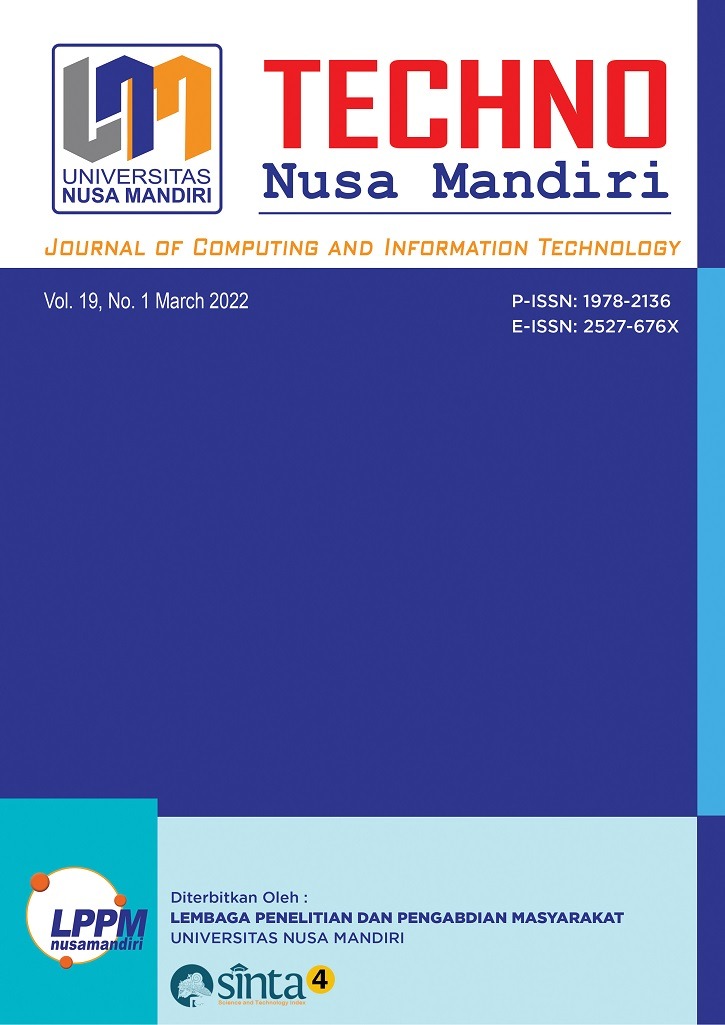DECISION SUPPORT SYSTEM FOR PURCHASING OF MIRRORLESS CAMERA USING WEIGHTED PRODUCT METHOD
DOI:
https://doi.org/10.33480/techno.v19i1.1722Keywords:
Mirrorless Camera, Weighted Product, Decision Support SystemAbstract
A mirrorless camera is a camera that does not have a mirror or a pentaprism with the size and workpiece of a compact camera, but has an equivalent capability to a DSLR camera. There are several mirrorless camera manufacturers widely known in the market, among others: Canon, Sony, Fujifilm, Nikon, Olympus, and Panasonic with the advantages of each manufacturer's specifications highlighted to enhance the attractiveness of consumers. With many types of mirrorless cameras in the market, many consumers are still confused in choosing which mirrorless camera is right and suited to their needs. Therefore, it takes a decision support system for the selection of mirrorless cameras using the weighted product method that can generate decisions about mirrorless cameras that comply with the selection of consumer criteria. The criteria used in this study are price, sensor size, megapixel, maximum ISO, and LCD. The results of this study show that the alternative mirrorless camera which has the highest value is the Olympus PEN E-PL9 camera with a value of 0.148.
References
Diana. 2018. Metode Dan Aplikasi Sistem Pendukung Keputusan. Yogyakarta: Deepublish Publisher.
Fajar. 2019. “Kamera DSLR vs Kamera Mirrorless? Temukan Perbedannya Di Sini!”
Frieyadie and Fariati Fariati. 2019. “Penerapan Metode Weighted Product Sebagai Pendukung Keputusan Seleksi Karyawan Baru Pt. Hi-Lex Indonesia.” Jurnal Riset Informatika 2(1):9–16.
Gani, Arman, Awang Harsa Kridalaksana, and Zainal Arifin. 2019. “Analisa Perbandingan Metode Simple Additive Weighting ( SAW ) Dan Weight Product ( WP ) Dalam Pemilihan Kamera Mirrorless.” 14(2).
Hermawan. 2016. “Apa Sih Kamera Mirrorless Itu?”
Hidayatulloh, Taufik, Satia Suhada, Eva Nursyifa, and Lestari Yusuf. 2018. “Pengambilan Keputusan Penerima Beasiswa Sma Menggunakan Fuzzy Multiple Atribute Decision Making Model Weighted Product.” Jurnal Pilar Nusa Mandiri 14(2):247.
Indrajani. 2015. Database Design. Jakarta: Elex Media Komputindo.
Kusrini. 2017. Konsep Dan Aplikasi Sistem Pendukung Keputusan. 1st ed. Yogyakarta: Andi Publisher.
Maruloh, Mohammad Darussalam, Mochamad Nandi Susila, and Wahyudia. 2020. “Sistem Penunjang Keputusan Seleksi Karyawan Terbaik PT. Golden Living Indonesia Dengan Metode Weighted Product.” VI(1):81–88.
MZ, Yumarlin. 2018. “Prototype Sistem Pendukung Keputusan Pemilihan Kamera Digital.” Jurnal Informasi Interaktif 3(1):95–103.
Nofriansyah, Dicky and Sarjon Defit. 2017. Multi Criteria Decision Making (MCDM) Pada Pendukung Keputusan. Cetakan Pe. Yogyakarta: Penerbit Deefpublish.
Putra, Guntur Maha, Novica Irawati, Sistem Informasi, and Stmik Royal. 2018. “Analisis Pemilihan Handphone Rekomendasi Dengan Metode Weighted Product.” Pp. 199–204 in Seminar Nasional Royal (SENAR) 2018. Vol. 9986. Medan: STMIK ROYAL.
Sari, Febriana. 2018. Metode Dalam Mengambil Keputusan. Yogyakarta: Deepublish.
Simangunsong, P. B. N. and Soni Bahagia Sinaga. 2019. “Sistem Pendukung Keputusan Pemilihan Dosen Berprestasi.” 58.
Sugiyono. 2019. Metode Penelitian Kuantitatif, Kualitatif, Dan R&D. edited by Sutopo. Bandung: Alfabeta.
Sumarsih, Nur. 2019. “Perancangan Dan Penerapan Metode Weighted Product Dalam Sistem Pendukung Keputusan Pembelian Laptop.” 1(4):207–10.
Susmikawati, Y. and S. Sunarti. 2017. “Pengaruh Country Of Origin Terhadap Perceived Quality Dan Minat Beli Konsumen (Studi Pada Calon Konsumen Yang Berminat Membeli Kamera Mirrorless Fujifilm X-Series Di Kota Malang).” Jurnal Administrasi Bisnis S1 Universitas Brawijaya 49(2):88–95.
Wasti, Melati, Sari Hartini, and Rinawati. 2019. “Implementasi Metode Weighted Product Dalam Sistem Pendukung Keputusan Pemilihan Layanan Uang Elektronik Terbaik.” Jurnal Teknika 11(2):1131–37.
Zai, Yosa’aro, Mesran, and Efori Buulolo. 2017. “Sistem Pendukung Keputusan Untuk Menentukan Buah Rambutan Dengan Kualitas Terbaik Menggunakan Metode Weighted Product (WP).” Media Informatika Budidarma (MIB) 1(1):8–11.
Downloads
Published
How to Cite
Issue
Section
License
The copyright of any article in the TECHNO Nusa Mandiri Journal is fully held by the author under the Creative Commons CC BY-NC license. The copyright in each article belongs to the author. Authors retain all their rights to published works, not limited to the rights set out on this page. The author acknowledges that Techno Nusa Mandiri: Journal of Computing and Information Technology (TECHNO Nusa Mandiri) is the first to publish with a Creative Commons Attribution 4.0 International license (CC BY-NC). Authors can enter articles separately, manage non-exclusive distribution, from manuscripts that have been published in this journal into another version (for example: sent to author affiliation respository, publication into books, etc.), by acknowledging that the manuscript was published for the first time in Techno Nusa Mandiri: Journal of Computing and Information Technology (TECHNO Nusa Mandiri); The author guarantees that the original article, written by the stated author, has never been published before, does not contain any statements that violate the law, does not violate the rights of others, is subject to the copyright which is exclusively held by the author. If an article was prepared jointly by more than one author, each author submitting the manuscript warrants that he has been authorized by all co-authors to agree to copyright and license notices (agreements) on their behalf, and agrees to notify the co-authors of the terms of this policy. Techno Nusa Mandiri: Journal of Computing and Information Technology (TECHNO Nusa Mandiri) will not be held responsible for anything that may have occurred due to the author's internal disputes.
















